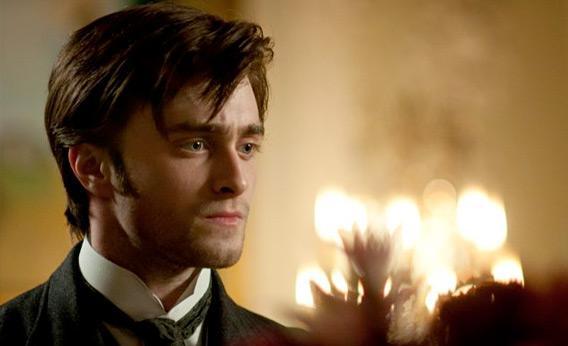Horror is a highly citational genre. Scary movies love to pay tribute to their stylistic predecessors, whether with nostalgic affection (homage), sly irony (spoof), or artful imitation (pastiche). Indeed, it seems like every horror movie that comes out these days self-consciously incorporates at least one of these approaches (or, more often, combines them all into a tonally incongruous mishmash). But coming across a horror film that’s just plain old-fashioned—not retro but square—is unusual. The Woman in Black, Daniel Radcliffe’s first post-Harry Potter outing, is as square as they come.
“Square” doesn’t necessarily mean “dull,” although to audiences weaned on the one-gory-death-per-15-minutes model of the postmillennial slasher film may find this melancholy ghost story laughably action-free. But there’s something to admire in The Woman in Black’s stouthearted commitment to the time-honored trappings of Gothic spookiness. In order to enjoy this film, the viewer needs to enjoy some scary-movie tropes that, for sophisticated viewers of the genre, may be too cliché to own up to. For example, how do you feel about a child’s nursery full of Victorian-era windup toys that suddenly, for no apparent reason, start jingling out their innocent, eerie tunes in a dark, empty mansion in the English countryside? If that sounds too corny and played-out to evoke even a faint shudder, The Woman in Black may not be for you. If, on the other hand, you’re not above acknowledging the trans-historical creepiness of a good dusty windup-doll shelf (Come on! It includes one of those hyper-realistic monkeys playing the cymbals!), this pokey, modestly budgeted thriller isn’t without its shivery delights.
The fusty haunted mansion in question is the wonderfully named Eel Marsh House, and the man being unsettled by the cymbal-clanking chimp is Arthur Kipps (Radcliffe), a widowed lawyer who’s been sent to go through the papers of the house’s now-dead proprietress. From the minute he arrives in the forbiddingly glum village of Crythin Gifford, something is off——pale, hollow-eyed children seem to peer at him from every window, and the proprietor of the town’s only inn insists that there’s no room available and Arthur must return to London at once.
But Arthur—who’s been slacking off at work since his beloved wife died giving birth to their son—has been warned he’ll be sacked if he doesn’t come back with the estate’s papers in order. So he accepts an offer of lodging from the town’s wealthiest man, Samuel Daily (Ciarán Hinds), a free-thinking skeptic who scoffs at the village superstition about a female ghost whose appearance always presages the death of a child. Oddly enough, though, Daily himself long ago lost a son—a tragedy that’s left his wife (Janet McTeer) prone to sudden spiritualist trances and bouts of automatic writing.
All it takes is one night alone at Eel Marsh House—a long, nearly dialogue-free, and wonderfully effective set piece involving bloody footprints and twisting doorknobs and seemingly sentient rocking chairs—to convince Arthur that something is indeed amiss in Crythin Gifford. But he has only hours to figure out who the storied “woman in black” is and what she wants, because his own son is arriving with his nanny on the morning train …
Based on a 1983 novel that was later adapted into a long-running West End play, The Woman in Black is one of the early films (along with the well-received 2010 vampire remake Let Me In) to emerge from the recently relaunched Hammer Studios, a production company best known for high-style, low-budget monster movies like The Curse of Frankenstein (1957) and the Christopher Lee Dracula films of the 60s and 70s. This film, scripted by Jane Goldman (The Debt, X-Men: First Class) and directed by James Watkins (Eden Lake), not only harks back aesthetically to its classic Hammer predecessors but at times appears to have been shot on their leftover sets. Cobwebs, velvet curtains, and forbidding oil portraits of stern ancestors figure largely in the Eel Marsh House decorating scheme. But The Woman in Black’s thematic concerns hark back to even older ghost stories like Henry James’ The Turn of the Screw, in which the moaning revenants double as figures for the protagonist’s repressed grief and longing. We know from early on that Arthur’s encounter with the woman in black—as real or imagined as she may be—will also represent an encounter with the memory of his dead wife; this movie’s symbolism, unlike its titular ghost, isn’t veiled. But that knowledge only makes the hero’s journey into the terrors of Eel Marsh (at one point he literally dives headlong into the marshy muck, plumbing the depths of bog and psyche alike) all the scarier.
Even if Radcliffe’s role here is largely passive and reactive—those blue-headlight eyes opening a fraction wider at each new supernatural shock—the erstwhile wizard is surprisingly believable as a grieving young father, and Hinds and McTeer provide classy backup. The movie’s final scene will strike some viewers as a gentle, poetic twist, others as a wussy cop-out. I’m well aware that The Woman in Black’s embrace of old-school creaky-floorboards scare tactics may leave hard-core horror aficionados scoffing. All I know is, when I had to walk down a dark hallway at home the night I came back from seeing it? Reader, I ran.
